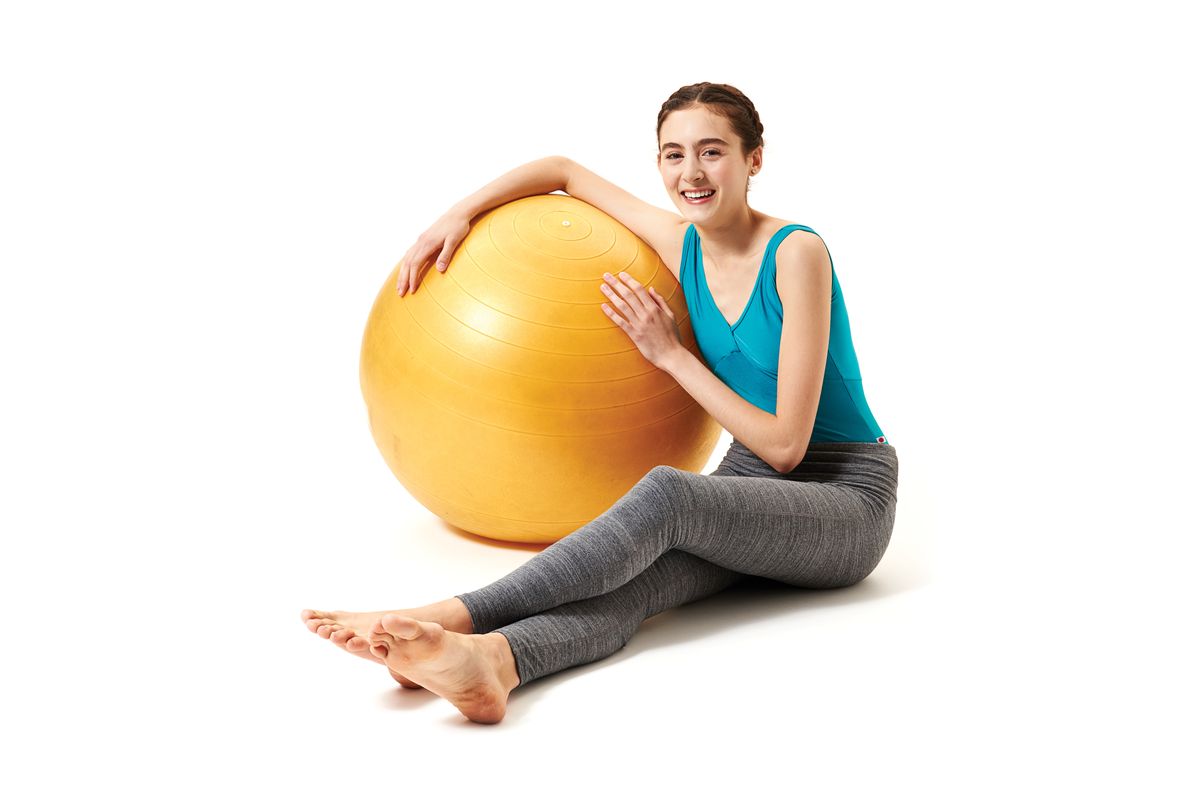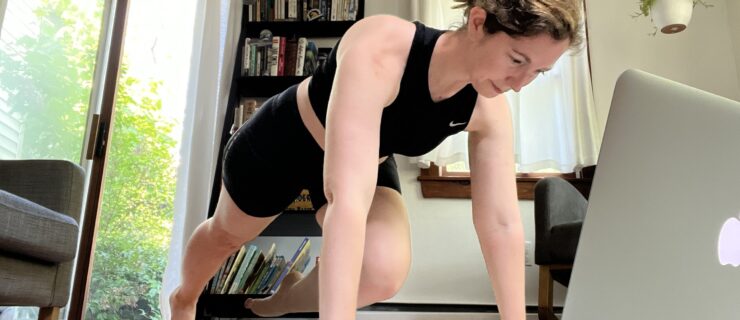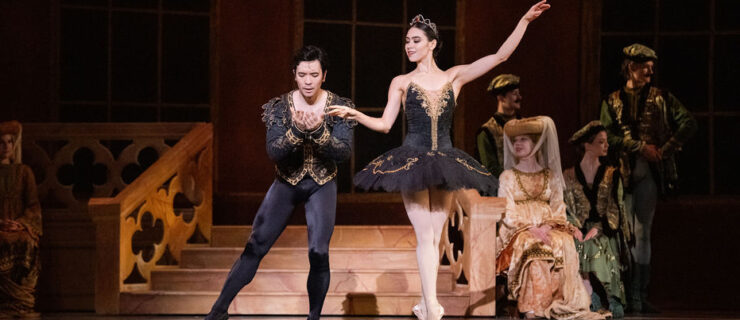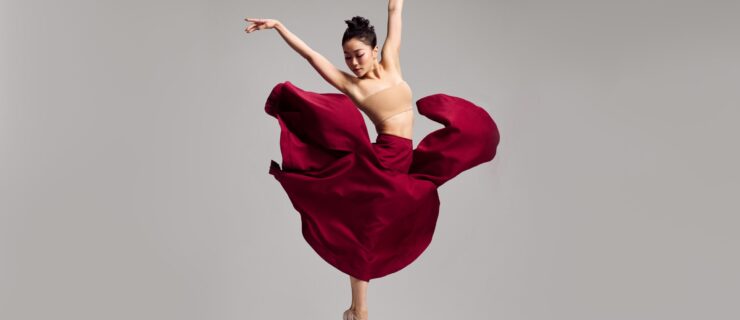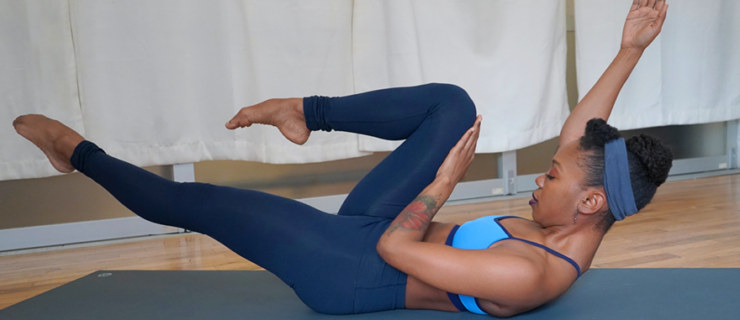Upcycle Your Workout (Without Buying New Stuff)
Pacific Northwest Ballet principal dancer Lesley Rausch says she did plenty of curls to tone her arms ahead of her summer wedding, but her physical therapist gave her another way to use those light free-weights that had a major impact on her jumps in the studio. “I stand in parallel first position and hold a weight in each hand with my arms at my sides, then engage my core and glutes to hinge forward at the hips with a neutral spine, before slowly raising my upper body back to standing,” says Rausch. It’s essentially a dead lift using your torso but also your hamstrings and all-important glutes, which power jumps. “Even though I’m not a natural jumper, I noticed after a few weeks that my petit allégro was faster and more effortless.”
While new fitness products and doodads are always coming to the market, there are myriad ways to use the fitness props you already own to revive a tired workout or stretching regimen. We asked Rausch and two physical therapists to share some inspiration for repurposing your foam rollers, Thera-Bands, physio balls, and other old standbys in the New Year.
The Tired Tool: Foam Roller
According to Maribeth Crupi, a physical therapist who treats Boston Ballet dancers, rolling out after class definitely aids with delayed-onset muscle soreness, but there are other ways your trusty foam roller can help with overall conditioning. She recommends lying lengthwise on a three-foot-long foam roller to challenge your stability during level-one Pilates exercises, like single-leg circles or the hundred—just be sure to modify the positions so that one or both feet are firmly planted on the floor to help stabilize you.
 Photographed for Pointe by Nathan Sayers, Modeled by Petra Love
Photographed for Pointe by Nathan Sayers, Modeled by Petra Love
A foam roller can also be used to correct slightly rounded shoulders, says Mark Baker, PT, DPT, OCS, who has treated dancers from Houston Ballet, Miami City Ballet and Los Angeles Ballet and has served as Inland Pacific Ballet’s physical therapist since 1999. “A lot of dancers don’t realize that while they work to strengthen their backs for better posture and port de bras, they must also stretch their muscles at the front of the shoulders—you can’t strengthen into a range you don’t have,” he says. Lying on the roller with your knees bent and feet flat on the floor for balance, bring your arms into first position, then open them into second, like a “T,” before letting them rest on the floor beside you. Relax into the stretch for one minute, then carry your arms through first and fifth position a few times before holding the stretch for one more minute.
 Photographed for Pointe by Nathan Sayers, Modeled by Petra Love
Photographed for Pointe by Nathan Sayers, Modeled by Petra Love
Rausch has a foam-roller fix for dancers who let go of their rib cage when their arms are in fifth, an issue that can cause problems in partnered pirouettes. Again, lying on the roller lengthwise with your feet planted on the floor, do a set of arm circles and scissors while controlling the movement of your rib cage with your core muscles, especially the obliques and transversus abdominis, she says. The instability of the roller also helps you gauge if you’re keeping your spine neutral and abs engaged while doing port de bras.
 Photographed for Pointe by Nathan Sayers, Modeled by Petra Love
Photographed for Pointe by Nathan Sayers, Modeled by Petra Love
Quick Tip:
You might be thinking about adding a Yamuna ball to your rolling routine, to target pressure points that your foam roller just can’t reach, like the front of the hip. Crupi, however, gives dancers 2.5-inch spongy-rubber Pinky balls that she orders in bulk from a party store—at a fraction of the price.
 Photographed for Pointe by Nathan Sayers, Modeled by Petra Love
Photographed for Pointe by Nathan Sayers, Modeled by Petra Love
The Tired Tool: Thera-Band
“I think we typically associate Thera-Bands with strengthening through the feet, but they’re so versatile,” says Rausch. “A lot of the dancers here at PNB do squats with the Thera-Band tied around the legs just above the knee or at the ankles, to strengthen the muscles that play a big role in lateral hip stability, like the gluteus medius.” This muscle group is critical when balancing on one leg and giving the working leg freedom to move independently, without compromising hip alignment. Sidestep across the room in a squat position, working the band with the leg that’s leading. Then return, facing the same direction but initiating the movement with the opposite leg first. You can also try straightening your legs (as shown below), keeping the pelvis neutral as you travel.
 Photographed for Pointe by Nathan Sayers, Modeled by Petra Love
Photographed for Pointe by Nathan Sayers, Modeled by Petra Love
Quick Tip: Complement your typical Thera-Band foot stretches with some strengthening on the go: Grab your ballet skirt and place the edge underneath your toes on the floor. Scrunch your toes, engaging the muscles that support your arch, and release, gradually gathering the whole skirt in under your foot. Then, using your toes, push the fabric back out inch by inch. If you’re recovering from swollen feet, Baker says, this exercise also helps to activate the lymphatic system that drains fluid.
 Photographed for Pointe by Nathan Sayers, Modeled by Petra Love
Photographed for Pointe by Nathan Sayers, Modeled by Petra Love
Quick Tip: Need a Thera-Band in a pinch? “A young dancer I work with was at a competition and used a spare pair of tights as a Thera-Band to warm up her feet,” says Crupi.
The Tired Tool: Physio Ball
You probably crunch and plank on your physio ball, but Rausch likes to use hers to take her bridges up a notch. “It’s much more challenging than bridging on the floor, so you definitely have to work up to it,” she says. Sit on the ball and walk your feet forward until the ball is supporting your head and upper back. Lift your hips into a slight bridge, engage your glutes (although your hamstrings will kick in no matter what), and hold. “You lose the floor’s support against your upper back, and if you add a leg lift at the top of your bridge, then gravity is working against you, too,” says Rausch. “You’ll strengthen muscles that support everything you do.” As you bridge, keep your hands on your hips or rest them lightly on the ball for support.
 Photographed for Pointe by Nathan Sayers, Modeled by Petra Love
Photographed for Pointe by Nathan Sayers, Modeled by Petra Love
 Photographed for Pointe by Nathan Sayers, Modeled by Petra Love
Photographed for Pointe by Nathan Sayers, Modeled by Petra Love
You can, of course, do crunches while seated on the ball, but Baker also suggests strengthening the abdominals on the floor by passing the ball from your legs to your hands. Lie on your back and hold a 55-centimeter stability ball between your legs, keeping them straight, with your arms stretched over your head. Engage your abdominals to jackknife your legs up, simultaneously reaching for the ball and transferring it to your hands. As you lie back and lower the legs, carry the ball over your torso to rest behind your head on the floor. Reverse the move to transfer the ball back to your legs and lower slowly to the floor—that’s one rep. Do 20.
 Photographed for Pointe by Nathan Sayers, Modeled by Petra Love
Photographed for Pointe by Nathan Sayers, Modeled by Petra Love
 Photographed for Pointe by Nathan Sayers, Modeled by Petra Love
Photographed for Pointe by Nathan Sayers, Modeled by Petra Love
 Photographed for Pointe by Nathan Sayers, Modeled by Petra Love
Photographed for Pointe by Nathan Sayers, Modeled by Petra Love
Quick Tip:
To test your balance and strengthen the area around the hip girdle, Crupi suggests these modified pliés: Standing on a yoga block or thick book with one foot in parallel and the other in a relaxed coupé, plié and straighten. The small platform and tiniest bit of height off the ground forces you to engage your core and helps you focus on straightening back up without hyperextending the knee. You can start by holding the barre for light support. Build up to 25 reps on each side.
 Photographed for Pointe by Nathan Sayers, Modeled by Petra Love
Photographed for Pointe by Nathan Sayers, Modeled by Petra Love
 Photographed for Pointe by Nathan Sayers, Modeled by Petra Love
Photographed for Pointe by Nathan Sayers, Modeled by Petra Love
Quick Tip:
Kneeling in front of your stability ball, say a quick prayer to the goddess of killer abs, then place your hands on the ball, and tip forward until your elbows are on top. Keep a stable core and do not flex at the hips. Roll back to neutral. Do 15 reps.
 Photographed for Pointe by Nathan Sayers, Modeled by Petra Love
Photographed for Pointe by Nathan Sayers, Modeled by Petra Love
